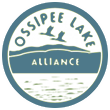Freedom—July 29, 2025—The N.H. Department of Environmental Services last week granted after-the-fact approval for nearly three dozen RV decks and porches built without permits in a 7,653 square foot area of Wabanaki Campground’s shoreline in Freedom.
Campground principal Mark Salvati hopes to sell shares of the property to the public as a cooperative. He has said he intends to address all of the property’s environmental and zoning issues as part of that process.
DES in January cited Mr. Salvati for violating the Shoreland Water Quality Protection Act. The Shoreland Act regulates all development within 250 feet of any public water body, including work on existing structures.
The Shoreland Act also limits the percentage of impervious surfaces in the shoreland, such as decks, roads and parking spaces. Exceeding the state’s maximum percentage of impervious surface coverage requires a professional stormwater management plan.
Neighbors and conservation groups had hoped DES would mandate a stormwater plan as part of requiring Salvati to address the structure violations. But he successfully argued that the impervious surface coverage in the campground shoreland was just 22.1%.
He said the McConkey Company of Tamworth made a “fairly large error” last year in a septic system application that stated the campground’s shoreland impervious surface coverage was 29.29%.
In correspondence with DES, Salvati said the “total roadway area” in the campground’s shoreland was 18,555 square feet, not the 30,777.96 square feet McConkey reported.
Mr. Salvati further reduced the impervious surface coverage by moving a tennis court out of the shoreland. He said the tennis court was 2,797 square feet, a number consistent with what the McConkey Company calculated last year. A month later, however, he restated the tennis court’s size to be 4,778 square feet, 71% larger.
As approved by DES, the 22.1% level of “pre-construction” impervious coverage will fall to 21.7% of “post-construction” impervious coverage, while impervious coverage from RVs and decks will increase 45%, from 8,812 square feet to 12,794 square feet.
In an email to Ossipee Lake Alliance, Salvati said DES was satisfied with his explanations of the changes he made to the permit application. He said he recalculated the roadway measurements after finding the McConkey Company included impervious roadway outside of the shoreland.
The size of the tennis court, he said, was originally based on a “standard 78 x 36 court,” and did not show additional areas being used for the sport.
DES said the state does not require a professional computation of shoreland impervious surface coverage, even for commercial businesses. It declined to answer other questions before the deadline for this story, but said it would do so as time allows.
Freedom Regulations Are Next
Mr. Salvati must also resolve local violations with Freedom officials. The town’s former Zoning Officer said in December that documented violations on the property could result in fines of up to $62,975.
In addition to decks and porches, the violations included expanding and refurbishing a “hutnick” cabin while approval for the construction work was pending with the Planning Board, and impermissibly adding an extra apartment to the Apartment Building after a fire in 2007.
The shoreland protection provisions in Freedom’s Zoning Ordinance are stricter than the state’s, and include a 300 ft. Shore Front District compared to the state’s 250 ft. shoreland.
A stormwater management system designed and certified by a professional engineer is required if the impervious surface coverage in the Shore Front District exceeds 25%, a level that some town officials believe has already been exceeded.
Independent calculations made earlier this year by Jeff Nicoll of Freedom’s Conservation Commission and Anne Cunningham of the Planning Board pegged the impervious surface coverage at 25.984% and 26.1%, respectively.
Town officials also face calls to address the findings of an independent professional evaluation of the property that was submitted to the town in February by neighbors.
Working from materials that Mr. Salvati submitted to the Planning Board, TND Engineering of Portsmouth concluded that all eight of the property’s so-called “hutnick” structures have been expanded into cabins without permits and have unapproved “bath” facilities.
TND additionally concluded that five of the “hutnicks” do not qualify as “campsites” in a “campground” as defined by state regulations, and two of the structures will require a special exception from the Zoning Board of Adjustment.
